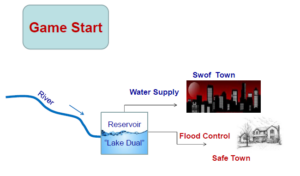Results of a risk-based decision-making game in water management
By Louise Crochemore, Maria-Helena Ramos, Florian Pappenberger, Schalk-Jan van Andel and Andy Wood
You might have participated in the water management game we played for the first time during the Hydrological ensemble prediction session at the EGU Assembly in 2013, or at the subsequent meetings and workshops where it was played [1]: EFAS users workshop in Reading, Drought Team meeting of the Interreg IVB DROP project in France, seminars at UQAC, CEHQ and IREQ in Quebec, Training course on Predictability, Diagnostics and Forecasting at ECMWF and the 10-year HEPEX workshop in Maryland.
A water management game
The game experiment focused on risk-based decision-making in water management using probabilistic forecasts of inflows to a reservoir. If you are curious to know the results of the game, as well as the conclusions we drawn from the applications, you may want to have a look at the paper that has just been accepted for publication in BAMS: see early online release here.
The paper presents a full analysis of the 162 game sheets collected during the applications of the game. It illustrates key issues on the use of probabilistic forecasts in sequential decision making. Our main conclusions pointed out to the following:
- Given the reservoir constraints, as expressed in the rules of the game, and the goals of the management, it was necessary to look at forecasts months ahead before deciding on the reservoir releases.
- Only approximately 20% of the game participants were able to finish the management season without exceeding the maximum reservoir capacity at any time during the sequenced decisions.
- Winners were those who had programmed the releases in a way that they succeeded to adequately decrease their reservoir volumes in the first two months, anticipating the potential high inflows.
- Losers of the game were those who did not recognize early enough the significance of the high inflow risk, or did not comprehend its potential impact on the reservoir volume.
Curiously, the high-score winner was from the audience of the HEPEX 10th Anniversary workshop in Maryland (someone who might be in the group photo in the photo gallery!)
Finally, the information collected from the worksheets and analysed in the paper shows which decisions were taken, but not why they were taken. There is therefore room for improvements of this game and for designing other games if one seeks to learn more about water management and decision-making using probabilistic forecasts in hydrology.
More training exercises and studies based on role-playing approaches are certainly needed in hydrological forecasting. So, why not submit a game for the sessions of the Hydrological Forecasting sub-division at the next EGU Assembly or for the HEPEX workshop in 2016?
[1] The game is based on an exercise designed by Kevin Werner, NWS. We adapted the exercise to a role-play game that could be played in a short time and during a conference presentation. Our version of the game is available from the HEPEX Portal (see page: Resources), under Creative Commons Public License. You can download and play it with your colleagues and/or students. Any feedback on its use for training or teaching is also welcome and can be communicated through the HEPEX blog on this website. Besides, if you develop other games, you can share it with the HEPEX community and also make it available online.

0 comments